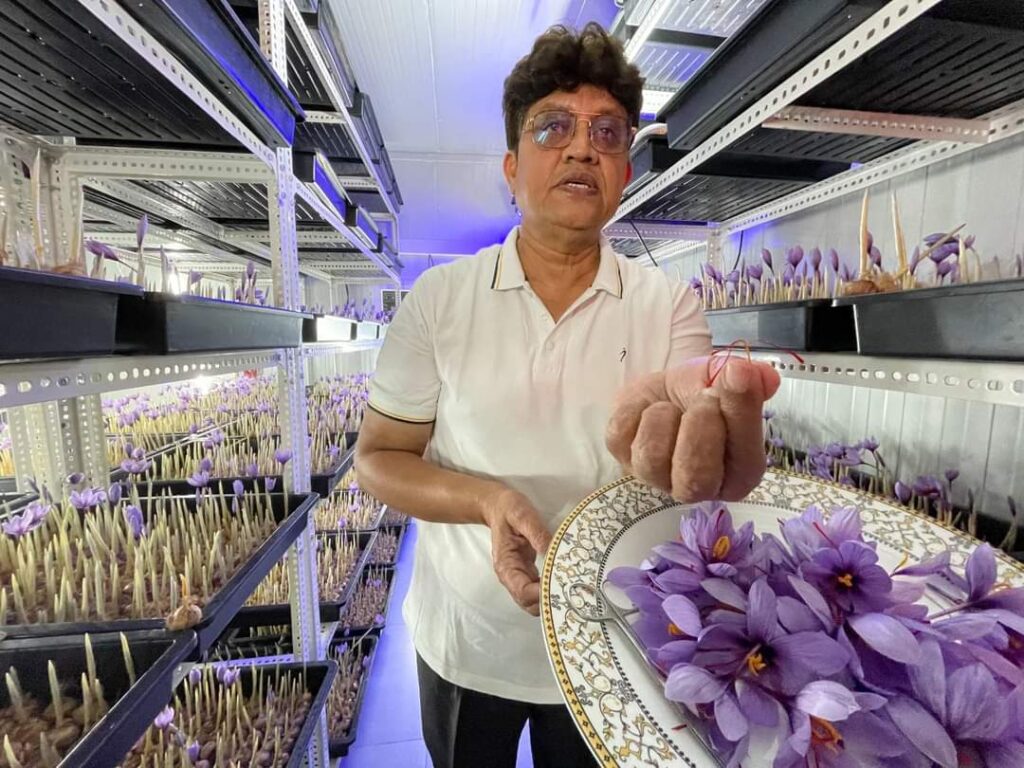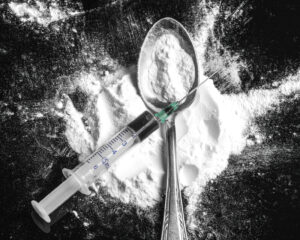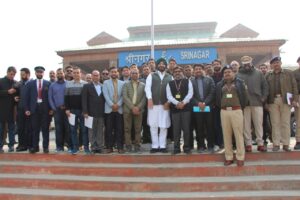Red Gold Revolution: Indore Man Grows Kashmir’s Priceless Saffron at Home

By Meer Altaf Hussain
In a remarkable agricultural achievement, Dr. Anil Garg from Indore, Madhya Pradesh, has successfully cultivated saffron—often termed “red gold” for its rarity and value—right in his home, inspired by the famed saffron fields of Kashmir. Traditionally grown in the cold, unique climates of Kashmir, saffron cultivation is usually limited to a few regions globally, making Dr. Garg’s accomplishment both unique and groundbreaking.
Background of the Red Gold
Saffron, one of the most expensive spices in the world, is derived from the delicate crimson stigmas of the Crocus sativus flower. Known for its vibrant color, rich aroma, and distinct flavor, saffron is central to various culinary and medicinal traditions, especially in Kashmir. The high cost of saffron is largely due to the labor-intensive harvesting process and the specific climatic conditions required for its growth.
The Kashmir Inspiration
Dr. Garg’s interest in saffron grew out of his admiration for the traditional methods and landscapes of Kashmir. He was inspired by the dedication of Kashmiri farmers who have nurtured the crop for generations. Determined to bring a piece of this rich heritage to Indore, he began a journey to recreate Kashmir’s saffron-growing conditions in a region far from its usual environment.
Innovation and Challenges
Growing saffron outside of its natural habitat posed numerous challenges, especially given Indore’s comparatively warmer and drier climate. Undeterred, Dr. Garg experimented with innovative techniques to mimic the colder temperatures essential for saffron flowering. He collaborated with a Kashmiri farmer, who provided expertise and saffron corms (bulbs) to initiate the project.
One significant technique involved the application of ice-cold water sprays during the crucial growing months of October and November. This method was used to simulate the cold climate needed to stimulate flowering, which otherwise might not have occurred in Indore’s warmer weather. His perseverance paid off as saffron flowers began to bloom, turning his home garden into a vibrant “Kesar Parvat” or “Saffron Hill.”
Results and Potential Impact
This success has shown that with the right techniques, saffron can be cultivated beyond Kashmir. Dr. Garg’s project offers hope to farmers and gardening enthusiasts in other regions who may now consider growing saffron, diversifying their crop options and potentially increasing local saffron availability.
Practical Tips for Aspiring Growers
For those inspired by Dr. Garg’s achievement, the basic steps to grow saffron at home include:
- Securing Quality Corms: Saffron bulbs (corms) are crucial for success, ideally sourced from a reputable supplier or experienced cultivator.
- Climate Simulation: Cooler conditions are essential, especially in autumn, as they trigger flowering.
- Watering Techniques: Adequate hydration, paired with methods to keep the soil temperature cool, is essential during initial growth phases.
- Patience and Care: Saffron requires meticulous care and may take several cycles to produce optimal blooms.
Conclusion
Dr. Garg’s experiment stands as a testament to agricultural innovation, showing how traditional cultivation can adapt to modern, non-traditional settings. Inspired by the Kashmir fields, his success story highlights the possibility of expanding saffron farming into new territories, potentially transforming the “red gold” market in India and beyond. His journey resonates as an example of how passion, experimentation, and resilience can bring the beauty of Kashmir’s “red gold” to homes far beyond its typical habitat.









